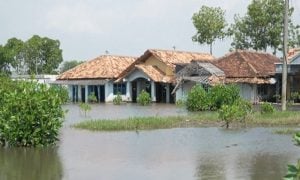ISLAMABAD: The Pakistan Meteorological Department (PMD) on Tuesday issued a high alert as heavy monsoon rains continue to sweep across the country, warning of the potential for flash floods, urban inundation, and landslides in several vulnerable regions over the next two days.
In its latest advisory, the PMD forecast widespread rain-wind and thunderstorms through 10 July, with particularly intense downpours expected in parts of Khyber Pakhtunkhwa, northeast Punjab, Azad Jammu and Kashmir, Gilgit-Baltistan, Islamabad, and Balochistan.
The weather forecast department warned that low-lying areas in major urban centres including Islamabad, Rawalpindi, Lahore, Gujranwala, Sialkot, Sargodha, Faisalabad, Peshawar, and Nowshera may face urban flooding.
According to the weather department, heavy rainfall is likely at isolated locations in Azad Kashmir, the Potohar region, northeastern Punjab, and both northeastern and southern parts of Balochistan.
The advisory also noted the risk of flash flooding in local streams and rainwater drains in districts such as Murree, Galliyat, Swat, Chitral, Kohistan, Abbottabad, and Mansehra.
In southern Balochistan, districts including Barkhan, Kohlu, Dera Bugti, Kalat, and Turbat are at risk of runoff-induced flooding due to persistent rainfall.
Landslides and mudslides could disrupt transport routes and lead to road closures, particularly in hilly and mountainous regions of Khyber Pakhtunkhwa and Azad Kashmir.
The PMD urged district administrations and local authorities to activate emergency response plans and monitor flood-prone zones closely.
“The public is urged to exercise caution and stay informed as rain continues in the coming days,” the department said in a statement.
Monsoon rains continue to lash Pakistan, with further downpours expected in upper parts till July 10, 2025 pic.twitter.com/LyMXmkYObi
— Pak Met Department محکمہ موسمیات (@pmdgov) July 8, 2025
The ongoing monsoon system has already caused significant damage. At least 19 people have died in the past 48 hours in Balochistan, Khyber Pakhtunkhwa, and the Islamabad-Rawalpindi region due to rain-related incidents, according to official reports.
The National Emergencies Operation Centre (NEOC) has also issued a flood warning for multiple regions.
Prime Minister Shehbaz Sharif has also directed the National Disaster Management Authority (NDMA) to remain fully prepared for emergency relief operations.
Rainfall figures released by the PMD for the past 24 hours show Sheikhupura in Punjab received 48 mm of rainfall, Lahore 75 mm, and Islamabad 37 mm across various monitoring stations.
In Khyber Pakhtunkhwa, Balakot recorded 40 mm, Kakul 31 mm, and Malam Jabba 17 mm.
Balochistan’s Kalat and Ziarat received 17 mm and 12 mm respectively, while parts of Azad Kashmir, including Muzaffarabad, recorded up to 13 mm.
In Sindh, only light rain or drizzling was reported, with Badin receiving 4 mm and Karachi recording traces of rain.
The monsoon season in Pakistan, which typically spans June to September, plays a vital role in replenishing water supplies and supporting agriculture.
However, it also brings the annual risk of widespread flooding, displacement, and infrastructure damage in areas with poor drainage or dense populations.
























